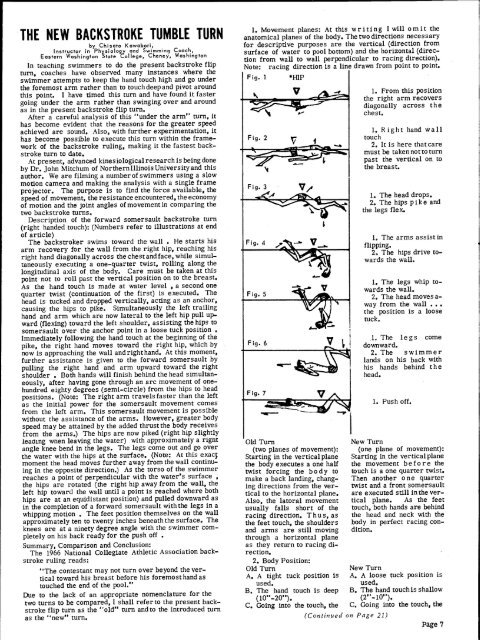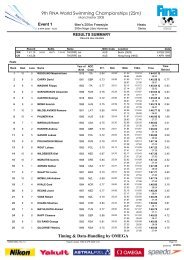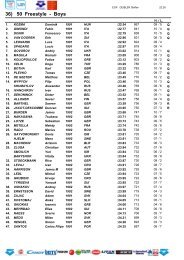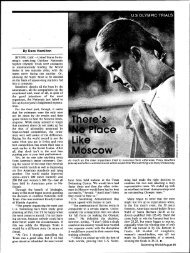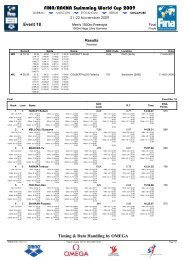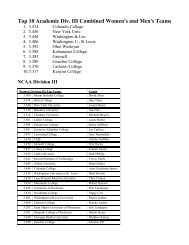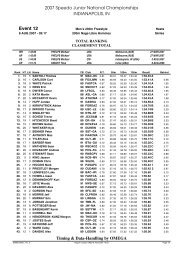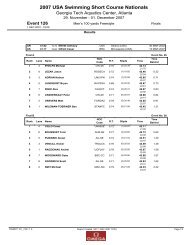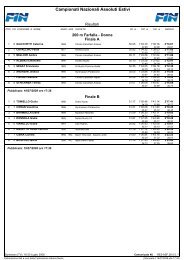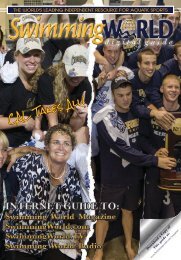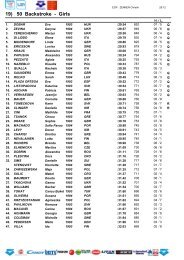the new backstroke tumble turn - Swimming World Magazine
the new backstroke tumble turn - Swimming World Magazine
the new backstroke tumble turn - Swimming World Magazine
You also want an ePaper? Increase the reach of your titles
YUMPU automatically turns print PDFs into web optimized ePapers that Google loves.
THE NEW BACKSTROKE TUMBLE TURN<br />
by Chisato Kawabori,<br />
nstructor in Physiology and <strong>Swimming</strong> Coach,<br />
Eastern Washington State Col ege, Cheney, Washington<br />
In teaclaing swimmers to do <strong>the</strong> present <strong>backstroke</strong> flip<br />
<strong>turn</strong>, coaches have observed many instances where <strong>the</strong><br />
swimmer attempts to keep <strong>the</strong> hand touch high and go under<br />
<strong>the</strong> foremost arm ra<strong>the</strong>r than to touch deep and pivot around<br />
this point. I have timed this <strong>turn</strong> and have found it faster<br />
going under <strong>the</strong> arm ra<strong>the</strong>r than swinging over and around<br />
as in <strong>the</strong> present <strong>backstroke</strong> flip <strong>turn</strong>.<br />
After a careful analysis of this "under <strong>the</strong> arm" <strong>turn</strong>, it<br />
has become evident that <strong>the</strong> reasons for <strong>the</strong> greater speed<br />
achieved are sound. Also, with fur<strong>the</strong>r experimentation, it<br />
has become possible to execute this <strong>turn</strong> within <strong>the</strong> framework<br />
of <strong>the</strong> <strong>backstroke</strong> ruling, making it <strong>the</strong> fastest <strong>backstroke</strong><br />
<strong>turn</strong> to date.<br />
At present, advanced kinesiological research is being done<br />
by Dr. John Mitchum of Nor<strong>the</strong>rn lllinois University and this<br />
author. We are filming a number of swimmers using a slow<br />
motion camera and making <strong>the</strong> analysis with a single frame<br />
projector. The purpose is to find <strong>the</strong> force available, <strong>the</strong><br />
speed of movement, <strong>the</strong> resistance encountered, <strong>the</strong> economy<br />
of motion and <strong>the</strong> joint angles of movement in comparing <strong>the</strong><br />
two <strong>backstroke</strong> <strong>turn</strong>s.<br />
Description of <strong>the</strong> forward somersault <strong>backstroke</strong> <strong>turn</strong><br />
(right handed touch): (Numbers refer to illustrations at end<br />
of article)<br />
The <strong>backstroke</strong>r swims toward <strong>the</strong> wall . He starts his<br />
arm recovery for <strong>the</strong> wall from <strong>the</strong> right hip, reaching his<br />
right hand diagonally across <strong>the</strong> chest andface, while simultaneously<br />
executing a one-quarter twist, roiling along <strong>the</strong><br />
longitudinal axis of <strong>the</strong> body. Care must be taken at this<br />
point not to roll past <strong>the</strong> vertical position on to <strong>the</strong> breast.<br />
As <strong>the</strong> hand touch is made at water level , a second one<br />
quarter twist (continuation of <strong>the</strong> first) is executed. The<br />
head is tucked and dropped vertically, acting as an anchor,<br />
causing <strong>the</strong> hips to pike. Simultaneously <strong>the</strong> left trailing<br />
hand and arm which are now lateral to <strong>the</strong> left hip pull upward<br />
(flexing) toward <strong>the</strong> left shoulder, assisting <strong>the</strong> hips to<br />
somersault over <strong>the</strong> anchor point in a loose tuck position .<br />
Immediately following <strong>the</strong> hand touch at <strong>the</strong> beginning of <strong>the</strong><br />
pike, <strong>the</strong> right hand moves toward <strong>the</strong> right hip, which by<br />
now is approaching <strong>the</strong> wall and righthand. At this moment,<br />
fur<strong>the</strong>r assistance is given to <strong>the</strong> forward somersault by<br />
pulling <strong>the</strong> right hand and arm upward toward <strong>the</strong> right<br />
shoulder . Both hands will finish behind <strong>the</strong> head simultaneously,<br />
after having gone through an arc movement of onehundred<br />
eighty degrees (semi-circle) from <strong>the</strong> hips to head<br />
positions. (Note: The right arm travels faster than <strong>the</strong> left<br />
as <strong>the</strong> initial power for <strong>the</strong> somersault movement comes<br />
from <strong>the</strong> left arm. This somersault movement is possible<br />
without <strong>the</strong> assistance of <strong>the</strong> arms. However, greater body<br />
speed may be attained by <strong>the</strong> added thrust <strong>the</strong> body receives<br />
from <strong>the</strong> arms.) The hips are now piked (right hip slightly<br />
leading when leaving <strong>the</strong> water) with approximately a right<br />
angle knee bend in <strong>the</strong> legs. The legs come out and go over<br />
<strong>the</strong> water with <strong>the</strong> hips at <strong>the</strong> surface. (Note: At this exac]~<br />
moment <strong>the</strong> head moves fur<strong>the</strong>r away from <strong>the</strong> wail continuing<br />
in <strong>the</strong> opposite direction.) As <strong>the</strong> torso of <strong>the</strong> swimmer<br />
reaches a point of perpendicular with <strong>the</strong> water's surface ,<br />
<strong>the</strong> hips are rotated (<strong>the</strong> right hip away from <strong>the</strong> wail, <strong>the</strong><br />
left hip toward <strong>the</strong> wall until a point is reached where both<br />
hips are at an equidistant position) and pulled downward as<br />
in <strong>the</strong> completion of a forward somersault with<strong>the</strong> legs in a<br />
whipping motion . The feet position <strong>the</strong>mselves on <strong>the</strong> wall<br />
approximately ten to twenty inches beneath <strong>the</strong> surface. The<br />
knees are at a ninety degree angle with <strong>the</strong> swimmer completely<br />
on his back ready for <strong>the</strong> push off .<br />
Summary, Comparison and Conclusion:<br />
The 1966 National Collegiate Athletic Association <strong>backstroke</strong><br />
ruling reads:<br />
"The contestant may not <strong>turn</strong> over beyond <strong>the</strong> vertical<br />
toward his breast before his foremost hand as<br />
touched <strong>the</strong> end of <strong>the</strong> pool."<br />
Due to <strong>the</strong> lack of an appropriate nomenclature for <strong>the</strong><br />
two <strong>turn</strong>s to be compared, I shall referto <strong>the</strong> present <strong>backstroke</strong><br />
flip <strong>turn</strong> as <strong>the</strong> ':old" <strong>turn</strong> andto <strong>the</strong> introduced <strong>turn</strong><br />
as <strong>the</strong> "'<strong>new</strong>" <strong>turn</strong>.<br />
1. Movement planes: At this writing I will omit <strong>the</strong><br />
anatomical planes of <strong>the</strong> body, The two directions necessary<br />
for descriptive purposes are <strong>the</strong> vertical (direction from<br />
surface of water to pool bottom) and <strong>the</strong> horizontal (direc-<br />
tion from wall to wall perpendicular to racing direction).<br />
Note: racing direction is a line drawn from point to point.<br />
g ig. 1 *HIP<br />
~ ~ ~ _ ~ ~ - ~ m 1. From this position<br />
- <strong>the</strong> right arm recovers<br />
diagonally across <strong>the</strong><br />
chest.<br />
Fig. 2<br />
V<br />
Fig. 3 V/<br />
Fig. 5 ~ ~,, 1<br />
Fig. 6 V ~i<br />
L<br />
Fig. 7 ~<br />
Old Turn<br />
(two planes of movement):<br />
Starting in <strong>the</strong> vertical plane<br />
<strong>the</strong> body executes a one half<br />
twist forcing <strong>the</strong> body to<br />
make a back landing, changing<br />
directions from <strong>the</strong> vertical<br />
to <strong>the</strong> horizontal plane.<br />
Also, <strong>the</strong> latoral movement<br />
usually falls short of <strong>the</strong><br />
racing direction. Thus, as<br />
<strong>the</strong> feet touch, <strong>the</strong> shoulders<br />
and arms are still moving<br />
through a horizontal plane<br />
as <strong>the</strong>y re<strong>turn</strong> to racing direction.<br />
2. Body Position:<br />
Old Turn<br />
A. A tight tuck position is<br />
used.<br />
B. The hand touch is deep<br />
(10"-20").<br />
C. Going into <strong>the</strong> touch, <strong>the</strong><br />
(Continued on Page 2I)<br />
1. Right hand wall<br />
touch<br />
2. It is here that care<br />
must be taken notto <strong>turn</strong><br />
past <strong>the</strong> vertical on to<br />
<strong>the</strong> breast.<br />
1. The head drops.<br />
2. The hips p i k e and<br />
<strong>the</strong> legs flex.<br />
1. The arms assist in<br />
flipping.<br />
2. The hips drive towards<br />
<strong>the</strong> wall.<br />
1. The legs whip towards<br />
<strong>the</strong> wall.<br />
2. The head moves a-<br />
way from <strong>the</strong> wall ...<br />
<strong>the</strong> position is a loose<br />
tuck.<br />
1. The legs come<br />
downward.<br />
2. The swimmer<br />
lands on his back with<br />
his hands behind <strong>the</strong><br />
head.<br />
1. Push off.<br />
New Turn<br />
(one plane of movement):<br />
Starting in <strong>the</strong> vertical plane<br />
<strong>the</strong> movement b e f o r e <strong>the</strong><br />
touch is a one quarter twist.<br />
Then ano<strong>the</strong>r one quarter<br />
twist and a front somersault<br />
are executed still in<strong>the</strong> vertical<br />
plane. As <strong>the</strong> feet<br />
touch, both hands are behind<br />
<strong>the</strong> head and neck with <strong>the</strong><br />
body in perfect racing condition.<br />
New Turn<br />
A. A loose tuck position is<br />
used.<br />
B. The hand touch is shallow<br />
(2"-10").<br />
C. Going into <strong>the</strong> touch, <strong>the</strong><br />
Page 7
BE A WINNER!<br />
IN THE TANK AND OUT...<br />
Start right by outfitting your team in<br />
Win. Lane Co. Dress Warm-ups.<br />
WM. LANE CO.<br />
DRESS WARM-UPS<br />
lk Your team will be far ahead with exclusive<br />
color designs tailored specifically<br />
for your team. The Lane warm-ups are<br />
made of washable miracle fiber with durene<br />
knit trim.<br />
dk' We have special colors for team orders,<br />
and <strong>the</strong>y are custom made to individual<br />
measurements. And best of al|, <strong>the</strong>y're<br />
priced right so that every team can afford<br />
<strong>the</strong>m.<br />
Individual orders are welcomed. Please<br />
remember that on less than team orders,<br />
all colors and combinations are not always<br />
in stock or available.<br />
OUR WARM-UPS SUIT CHAMPIONS<br />
• . .LET US SUIT YOU TOO!<br />
ALLSTANDARD ATHLETIC COLORS<br />
IMPORTANT: List color preference when.writing for<br />
team or single unit orders.<br />
Water Polo Coaches Attention:<br />
Win. Lane Co. 1967 rules permit colored<br />
. . . . . . caps. They are special order.<br />
ZUI ~0. nroaaway $2.00 single digets and $2.35<br />
Los Angeles, Calif. 90007 dc~]~ ~e'n~'mbS~e~2[~r ~P.<br />
Tel. (2131 748-1982 or 749-4895s!red when ordering.<br />
"Superior to anything I've ever used," says Coach<br />
, ,<br />
TUMBLE TURN (Continued/tom Page 7)<br />
body is at full length posi- body is piked at <strong>the</strong> hips<br />
tion, making a longradius making a short radius.<br />
and a longerperiodofex- Thus, <strong>the</strong>re is a shorter<br />
ecution,<br />
period required for execution.<br />
3. Water Resistance Encountered During Execution:<br />
Old Turn<br />
New Turn<br />
The frontal area of <strong>the</strong> During <strong>the</strong> frontsomersanlt,<br />
thighs, hips and torso lift <strong>the</strong> hips are at water level,<br />
against <strong>the</strong> water during <strong>the</strong> The main resistance is eninitial<br />
movement toward <strong>the</strong><br />
wall.<br />
countered at <strong>the</strong> back of <strong>the</strong><br />
head and upper shoulders.<br />
This serves as an ideal<br />
anchor for a "pole vaulting"<br />
movement. The hips pike and<br />
<strong>the</strong> legs lift over <strong>the</strong> water,<br />
encountering little resistance.<br />
The <strong>new</strong> <strong>backstroke</strong> <strong>turn</strong> seems to have less wasted movements,<br />
less negative resistance, uses a shorter radius for<br />
gre~iter speed of movement, and allows <strong>the</strong> swimmer to stay<br />
in one plane. When done correctly, <strong>the</strong> swimmer using <strong>the</strong><br />
<strong>new</strong> <strong>turn</strong> appears to be bouncing off <strong>the</strong> wall like a rubber<br />
ball ra<strong>the</strong>r than momentarily "hanging up". Extreme care<br />
must be paid to <strong>the</strong> near vertical position from back to<br />
breast at <strong>the</strong> moment of touch in order to stay within <strong>the</strong><br />
NCAA rultnff...<br />
i<br />
SPECIAL OFFER<br />
ON YOUR PASS TO FAME<br />
T he <strong>Swimming</strong> Hall of Fame at Fort Lauderdale<br />
is now in <strong>the</strong> final stage of construction. Ground<br />
was broken last December for <strong>the</strong> 196,000 do.liar<br />
building. It will be completed by <strong>the</strong> end of <strong>the</strong><br />
year...to house swimming's greatest research library,<br />
museum and memorabelia.<br />
For a iimited tirne, you Can have <strong>the</strong> privilege of<br />
membership in <strong>the</strong> <strong>Swimming</strong> Hall of Fame at a<br />
price you can afford. You can be a part at this great<br />
swimming institute.<br />
I f you ar(; a swimmer, coach, parent, official...<br />
anyone who has been officially involved with<br />
swimming, cllving or aquatic sports, now is <strong>the</strong> time<br />
to secure <strong>the</strong> exclusive <strong>Swimming</strong> Hall of Fame Life<br />
Time Gold Pass. It's your golden key to great moments<br />
of swimming, <strong>the</strong> past and <strong>the</strong> future.<br />
I' he cost is $25.00 down with three years to pay<br />
/ <strong>the</strong> remaining $75.00.<br />
PULL-BUOY<br />
, For Teaching, Training & Conditioning<br />
It s here . . . PULL-BUOY, <strong>the</strong> most et[ective, most<br />
e~cient device yet designed for in-<strong>the</strong>-water development<br />
of <strong>the</strong> arms. A must in any swimming program,<br />
age group or senior.<br />
• On and off quickly. Adjustable fit.<br />
• Floats body in normal swimming position.<br />
• Permits any path of pull and recovery.<br />
• Permits racing dives and flip <strong>turn</strong>s.<br />
• No effort required to hold in place.<br />
~ ~ $2.2~ each, $27.48 doz.<br />
~ ~ , $2.39 each, $28.68 doz.<br />
~ ~ • $2.49 each. $29.88 doz.<br />
For Smell Swlmmers-.-6" (3" die.) $1.99 each, $23.88 doz.<br />
Unbreakable Polyethylene Kickboard$: $1.99 each, $23.88 doz.<br />
ALL CHARGE ORDERS F.O.B.<br />
PULL BUOY, INC.<br />
1623 Kingsmere Circle, Rochester, Mich•<br />
There are o<strong>the</strong>r ways you can help your Hall of Fame<br />
help swimming. There are Pounders ($5000), Charter<br />
($10001 and Club ($200) Memberships with corresponding<br />
privileges. There is a Hall of Fame Meet program (one to<br />
a community). There are 1965 and 1966 Hal/of Fame International<br />
Meet Souvenir programs, plus official patches/<br />
charms, pins, buttons and license plates using <strong>the</strong> Hall or<br />
Fame !nsignia fo r $!.00 each.<br />
For more information on how to be a Gold Pass member,<br />
its privileges and o<strong>the</strong>r types of membership, etc, write or<br />
use <strong>the</strong> coupon below.<br />
sWIMMiNG HALL OF FAME<br />
.501 Seobreeze Avenue<br />
Fort Lauderdale, Florida 33316<br />
Name<br />
Street<br />
City ~tate. Zip<br />
Page 21


